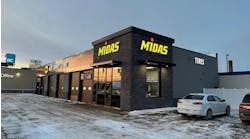For years, before my passion became supporting the independent tire dealer, I spent my time trying to outperform my last time, literally. I networked, strategized, spent endless hours training and evaluated every step so the next was smoother, faster, better informed and more productive.
I sought the advice of professionals, surrounded myself with those who had a strong vision and dialed all things in my life around a single goal.
Along the way, I learned that to be among the best involved much more than intent, dedication and talent. It involved real work.
So how do you zero in on — and fix — the things that are keeping your business from being among the best? Here are some tips:
Own your targets. The vision for your mission should have numerous targets along the way, with each intended to build on the prior in succession to advance towards whatever the end game is you're seeking. I often find that missing your target is the result of the failure to plan at the broadest levels. Instead, we tend to spend our time, energy and money chasing the shiny new object that just popped up. All those shiny new objects add up to a recipe for random and inconsistent results.
Understand your role. An organizational chart is a great place to start. Org charts, especially when accompanied by job descriptions, are a great source of reference when it comes to both long-term and short-term planning. They also can help decision makers evaluate a long list of essentials. You may be thinking, “I own or work in a single shop with only a few employees, so it seems silly to have an org chart.” You’re wrong. These tools not only provide the hierarchy, which clearly defines seniority and lines of authority, but also shows which roles are responsible for what tasks. This is essential to the efficiency of your business
Be a champion of the outcome. As leaders — which we all have the capacity to be — we should exemplify the behavior we want to see, rather than demand it. True champions have not only mastered the basics, but have taught them time and time again. Whether consciously or not, the people in your organization pay close attention to what you say and what you do. If what you're saying and doing isn't consistent, your actions will lead to frustration and lack of trust. Trust fuels collaboration and accountability, which increases engagement, productivity and loyalty.
As a recipe for solving some of your issues, let's assume the above points are accurate, which they are. Let's also say you've got them nailed. Next, your approach to the details when planning your path forward will affect the outcome in significant ways. This is where things get tricky.
They say it takes 30 to 90 days to change a behavior. What they don't tell you is how to maintain those behaviors as you change others.
If you work on two goals at a time and you stick with each for 60 days, it might seem that you, at the very least, will be able to work through 12 significant items in a year. The reality is, to make those changes part of your dealership’s culture, you need more like six to nine months of dedicated effort and follow through. Now, you’re down to a handful of meaningful changes.
This is where evaluating the changes you want to see, in terms of your long-term mission and vision, becomes super-important. Strategies like the 80/20 rule pay huge dividends here. In this case, the 80/20 rule means that of all the things you want to accomplish, you start with the one that gets you the majority of the way there, with as little effort as possible. Then you rinse and repeat.
We should all be asking ourselves, “What does it take to truly differentiate ourselves from the rest and compete at the highest levels?” Do you have the basic building blocks in place to make effective change last?




